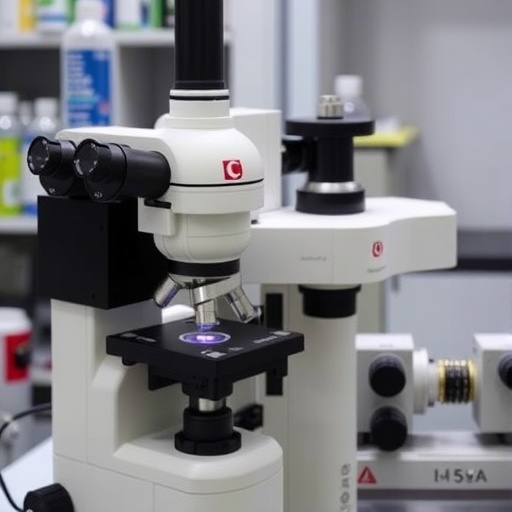In the rapidly evolving field of environmental science and geochemistry, precision and accuracy in elemental and isotopic analysis have become paramount. The advent of tandem inductively coupled plasma mass spectrometry (ICP-MS/MS) has revolutionized these domains by offering enhanced capabilities for geochemical, geochronological, and environmental applications. This cutting-edge review by Balaram, V., Glorie, S., Gilbert, S.E., et al., published in Environmental Earth Sciences in 2025, meticulously explores the transformative potential of ICP-MS/MS, shedding light on its multifaceted uses and setting the stage for future scientific breakthroughs.
ICP-MS, a well-established technique, has long been the gold standard for trace element and isotopic analyses due to its sensitivity and speed. However, the introduction of tandem mass spectrometry—a double quadrupole system—into ICP-MS systems marks a significant leap forward. By incorporating this tandem mechanism, ICP-MS/MS effectively mitigates common interferences that have traditionally hampered the reliability of analytical results, particularly in complex matrices encountered in geological and environmental samples.
One of the fundamental challenges addressed by ICP-MS/MS is the ubiquitous presence of polyatomic interferences. These are molecular ions formed from the plasma gas, solvent, or matrix that share the same mass-to-charge ratio as analyte ions, thereby confounding quantification. Tandem ICP-MS employs a first quadrupole to select precursor ions, a reaction cell to neutralize or transform interfering species, and a second quadrupole for final mass analysis. This sophisticated filtering strategy elevates the selectivity and lowers the detection limits beyond classical ICP-MS capabilities.
Geochemists frequently rely on the precise quantification of trace elements and isotopic ratios for unraveling the Earth’s history. The ability of ICP-MS/MS to differentiate between isotopes with minimal spectral overlap allows for enhanced geochronological dating techniques, including uranium-lead (U-Pb) dating and neodymium-samarium (Nd-Sm) systems. These improvements yield more accurate age determinations, crucial for constructing accurate timelines in tectonic studies, mineral exploration, and paleoclimate reconstructions.
Moreover, environmental monitoring stands to benefit immensely from this technology. The detection of heavy metals, radioactive isotopes, and emerging contaminants in air, water, and soil demands ultra-trace sensitivity and robustness against matrix interferences. ICP-MS/MS enables reliable screening of pollutants even in challenging environmental matrices, thereby supporting regulatory compliance and facilitating remediation efforts. Its rapid analysis and multi-element detection capacity further streamline environmental risk assessments on broader scales.
In addition to these traditional roles, ICP-MS/MS is proving instrumental in biogeochemical cycles studies. Understanding nutrient transport, metal bioavailability, and ecological impacts necessitates precise tracking of isotopic signatures linked to natural and anthropogenic processes. By providing detailed isotopic fingerprints, tandem ICP-MS helps delineate sources and sinks in complex environmental systems, enriching our knowledge of ecosystem dynamics.
The review article also delves into methodological advancements, including optimization of reaction gas chemistries within the collision/reaction cell. By selecting appropriate gases, interferences can be neutralized through specific chemical reactions, such as charge transfer, oxidation, or reduction, tailored to the target element. This adaptability makes ICP-MS/MS a highly versatile tool, suitable for a broad spectrum of elements ranging from transition metals to actinides.
Sample introduction techniques complement instrumental advances, with innovations aiming to reduce sample volume requirements and enhance sensitivity. Techniques like laser ablation coupled with ICP-MS/MS facilitate spot analyses of solid samples with minimal preparation. This opens avenues for in-situ characterization of mineral phases and environmental particulates, providing spatially resolved elemental and isotopic data critical for nuanced interpretations.
The authors highlight the need for standardization and interlaboratory comparisons to harness the full potential of ICP-MS/MS. Despite its powerful capabilities, instrument calibration, quality control, and data processing demand rigor to avoid analytical artefacts. Reference materials tailored for tandem ICP-MS are pivotal in this context, ensuring reproducibility and confidence across applications.
A significant portion of the review addresses future directions, including the integration of ICP-MS/MS with complementary techniques like laser ablation inductively coupled plasma mass spectrometry (LA-ICP-MS) imaging and time-of-flight ICP-MS. The synergy among these methods promises comprehensive datasets that merge spatial resolution with ultra-trace quantification, pushing the frontier of geochemical investigations.
Furthermore, the environmental sciences are increasingly embracing big data and machine learning to interpret complex analytical outputs. ICP-MS/MS datasets, rich in multi-element and isotopic information, present fertile ground for advanced computational techniques. These tools enable pattern recognition, anomaly detection, and predictive modelling that can accelerate insights into earth system processes and pollutant behaviors.
The review also underscores the relevance of ICP-MS/MS in contemporary challenges such as climate change and sustainable resource management. Accurate chemical and isotopic measurements of greenhouse gases, particulate matter, and critical raw materials inform policy development and technological innovations. The method’s ability to disentangle anthropogenic signals from natural backgrounds aids in tracking human impacts on the environment with unprecedented clarity.
In conclusion, tandem inductively coupled plasma mass spectrometry epitomizes the forefront of analytical instrumentation, extending the horizons of geochemical, geochronological, and environmental research. This comprehensive review elucidates the technique’s principles, diverse applications, and evolving methodologies, positioning ICP-MS/MS as an indispensable tool in addressing pressing scientific and societal challenges. As instrument designs improve and analytical protocols mature, the scientific community stands poised to unlock deeper insights into Earth’s composition, history, and the intricate interplay between natural systems and human activity.
Subject of Research: Tandem inductively coupled plasma mass spectrometry (ICP-MS/MS) and its geochemical, geochronological, and environmental applications.
Article Title: Geochemical, geochronological, and environmental applications of tandem inductively coupled plasma mass spectrometry (ICP-MS/MS): A review.
Article References:
Balaram, V., Glorie, S., Gilbert, S.E. et al. Geochemical, geochronological, and environmental applications of tandem inductively coupled plasma mass spectrometry (ICP-MS/MS): A review. Environ Earth Sci 84, 622 (2025). https://doi.org/10.1007/s12665-025-12611-8
Image Credits: AI Generated




